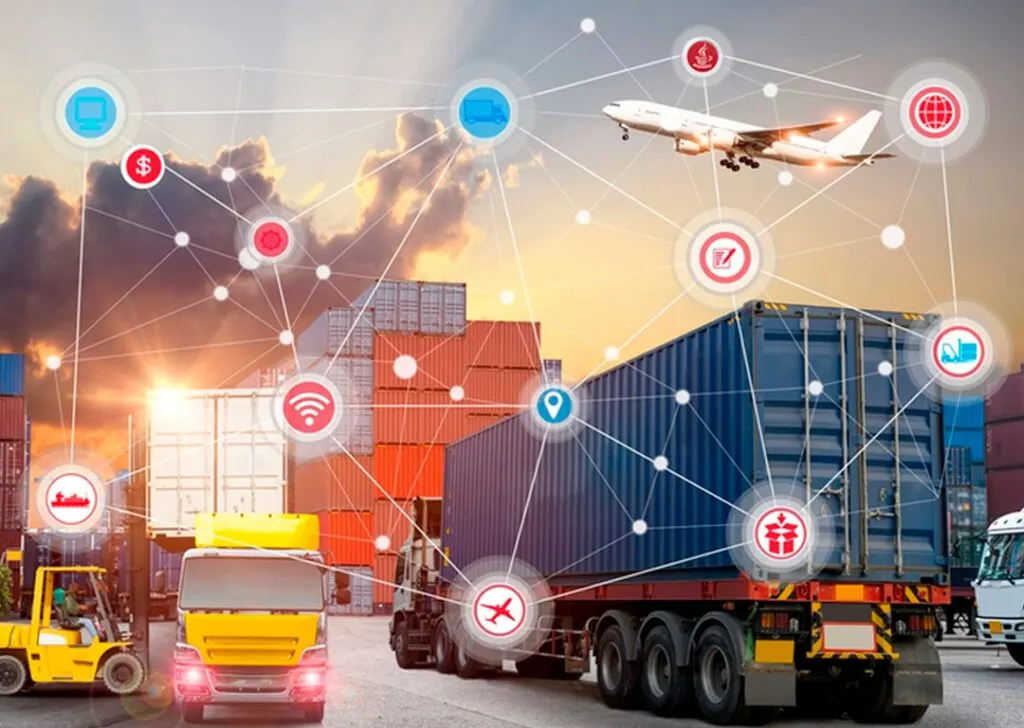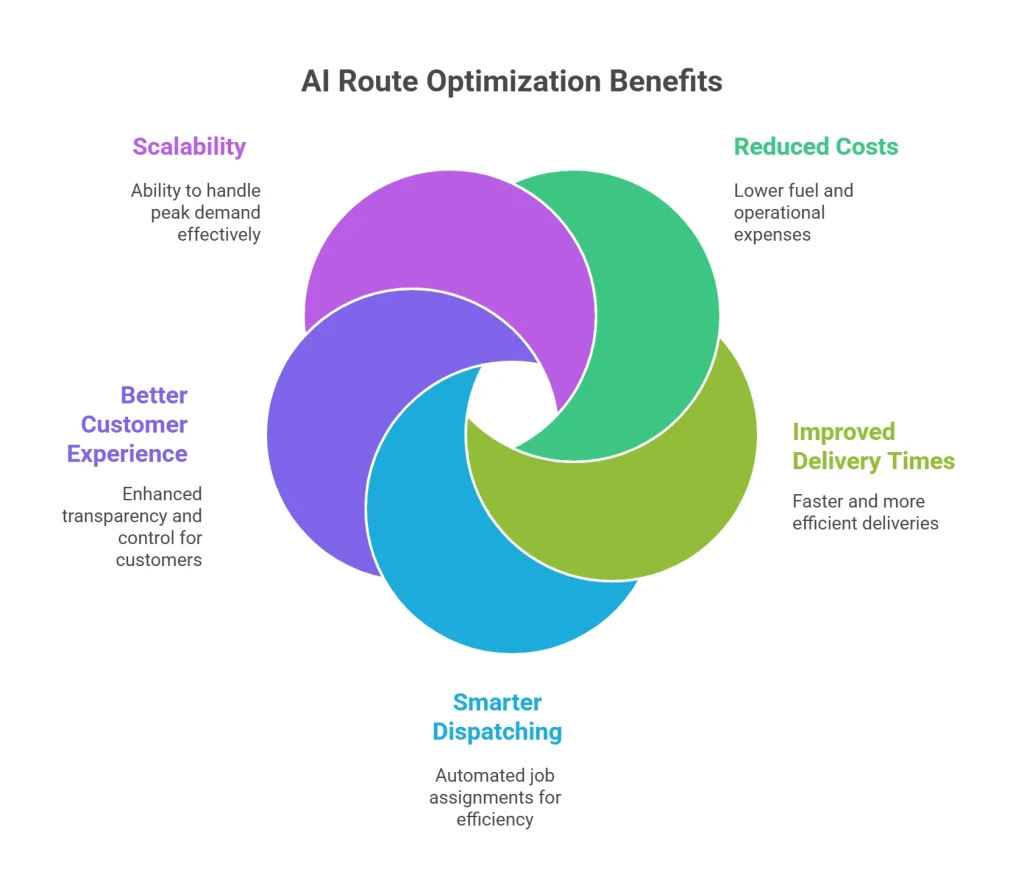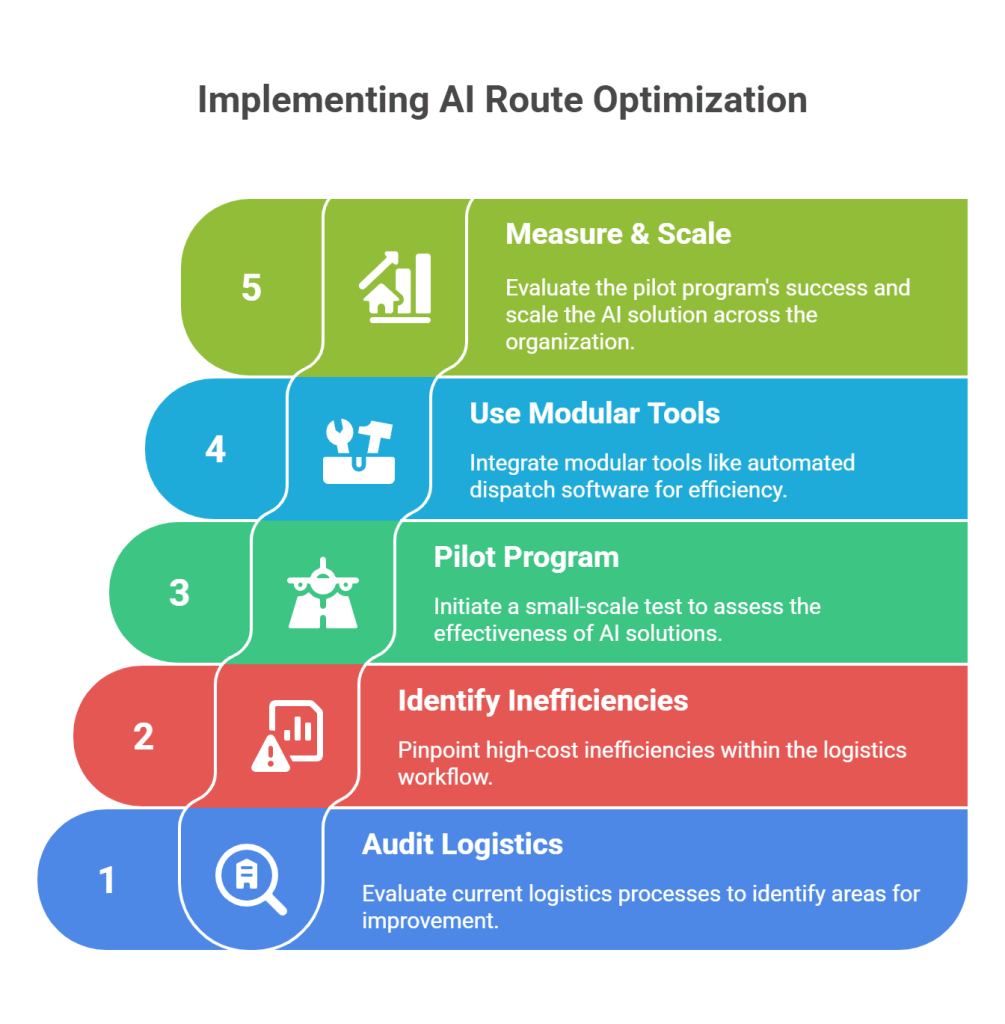In today’s on-demand world, where customers expect same-day or even same-hour deliveries, logistics companies can no longer afford inefficiencies.
Delays, fuel wastage, or misrouted vehicles directly impact both customer satisfaction and the bottom line. That’s where AI in logistics comes in – and it’s making route planning smarter, leaner, and more efficient than ever.

Why Traditional Route Planning Isn’t Enough Anymore
For decades, logistics teams have relied on historical data, maps, and dispatcher experience to plan delivery routes. While this approach may have worked in the past, it’s far from sufficient in today’s complex delivery ecosystems. Here’s why:
- It doesn’t factor in real-time conditions like traffic, weather, or road closures.
- Manual decisions can’t keep up with large fleets or dynamic delivery requests.
- Missed delivery windows often mean customer churn and increased costs.
This is why companies are now embracing AI route optimization as the backbone of modern logistics strategy.
How AI Makes Route Optimization Smarter
AI in route optimization goes far beyond GPS. It processes vast amounts of data -from customer preferences to weather reports – to create the most efficient delivery paths.
Here’s how it works:
| Feature | Traditional Routing | AI-Driven Routing |
| Data Source | Static maps | Real time data feeds |
| Route Recalculation | Manual | Automating based on changing conditions |
| Vehicle Capacity Planning | Basic | Smart allocations using constraints |
| Traffic and Weather Integration | Limited or none | Fully integrated |
| Predictive Delivery Windows | No | Yes |
Now that we understand how AI enhances route optimization, let’s explore its real-world benefits.
The Real-World Benefits of AI Route Optimization

- Reduced Fuel and Operational Costs
- Optimized routes mean less time on the road and lower fuel consumption.
- AI in logistics reduces last-mile delivery costs, which make up 53% of total shipping costs.
- Improved Delivery Times
- AI algorithms continuously re-route based on real-time updates.
- This ensures packages are delivered faster, even during peak hours or bad weather.
- Smarter Dispatching with Automation
- Companies like Shadowfax and Delhivery use automated dispatch software to assign jobs based on location, traffic, and driver availability.
- This removes manual inefficiencies and boosts fleet productivity.
- Better Customer Experience
- Predictive ETAs and live tracking create transparency.
- Customers feel more in control, reducing support calls and complaints.
- Scalability for Peak Loads
- During festive seasons or sale periods, AI effortlessly scales route planning for thousands of packages.
Now that we know how AI improves route efficiency and customer experience, let’s see how companies are applying it.
How Big Players Are Using AI for Logistics Route Planning
- Amazon leverages machine learning for AI route optimization that adapts to local conditions and driver behavior, enabling faster Prime deliveries.
- Flipkart uses logistics automation in India to dynamically plan routes during Big Billion Days sales, reducing missed deliveries.
- Blue Dart integrates artificial intelligence in supply chain to monitor shipment health and ensure timely deliveries using AI-based risk scoring.
These companies show how AI manufacturing solutions aren’t just for factories. They’re redefining the way logistics works.
Logistics Automation in India
India’s logistics sector is growing rapidly, driven by e-commerce, pharma, and grocery delivery. With it comes a growing interest in logistics automation in India. Here are key trends:
- Hyperlocal Deliveries: AI enables efficient micro-routing in cities like Mumbai and Bengaluru.
- EV and Fleet Optimization: Combining electric vehicles with AI in logistics reduces both carbon footprint and cost.
- Dynamic Re-Routing: AI instantly adjusts delivery routes if there’s a traffic jam or cancellation.
With this in mind, let’s look at what makes AI a long-term solution for route optimization.
What Makes AI a Long-Term Route Optimization Strategy
- Self-Learning Algorithms: The more data AI processes, the smarter it gets.
- Integrated with IoT: Sensors in vehicles provide real-time feedback.
- Works with Multiple Delivery Models: Whether it’s B2B, B2C or hyperlocal.
- Reduces Manual Intervention: Freeing up logistics teams for strategic tasks.
As we can see, AI route optimization is not a trend – it’s an operational edge. But how can companies start using it?
Getting Started with AI Route Optimization

Implementing AI in route optimization doesn’t have to be overwhelming. Here’s a basic roadmap:
- Audit Your Existing Logistics Workflow
- Identify High-Cost Inefficiencies
- Start Small with a Pilot Program
- Use Modular Tools (like automated dispatch software)
- Measure & Scale
Even modest investments in AI can lead to major efficiency gains in less than a year.
FAQs: Smarter Deliveries Begin with AI in Logistics: Know How
1. What is AI route optimization and how does it work?
AI route optimization uses machine learning and real-time data to calculate the most efficient delivery paths, reducing time, cost, and fuel consumption.
2. How is AI used in logistics automation in India?
Indian logistics companies use AI for dynamic dispatching, predictive ETA calculation, and real-time fleet tracking to streamline operations.
3. Can small businesses benefit from AI in logistics?
Yes. Cloud-based platforms offer scalable AI solutions tailored to SMEs, helping them automate routing and reduce costs.
4. What is automated dispatch software?
It’s a system that assigns delivery tasks to drivers based on factors like proximity, traffic, and availability, using AI logic.
5. How is artificial intelligence in supply chain different from ERP?
AI enhances decision-making in real-time, while ERP systems primarily manage static records. AI learns and improves over time.
Conclusion
AI in logistics is doing more than just optimizing routes. It’s redefining the meaning of speed, accuracy, and efficiency. In a world where delivery expectations are rising, AI route optimization is no longer optional; it’s essential.
Whether you’re a startup delivering groceries or a global 3PL, smart routing powered by artificial intelligence in supply chain could be your next big leap. Ready to outsmart traffic and out deliver competition? Start with AI.






